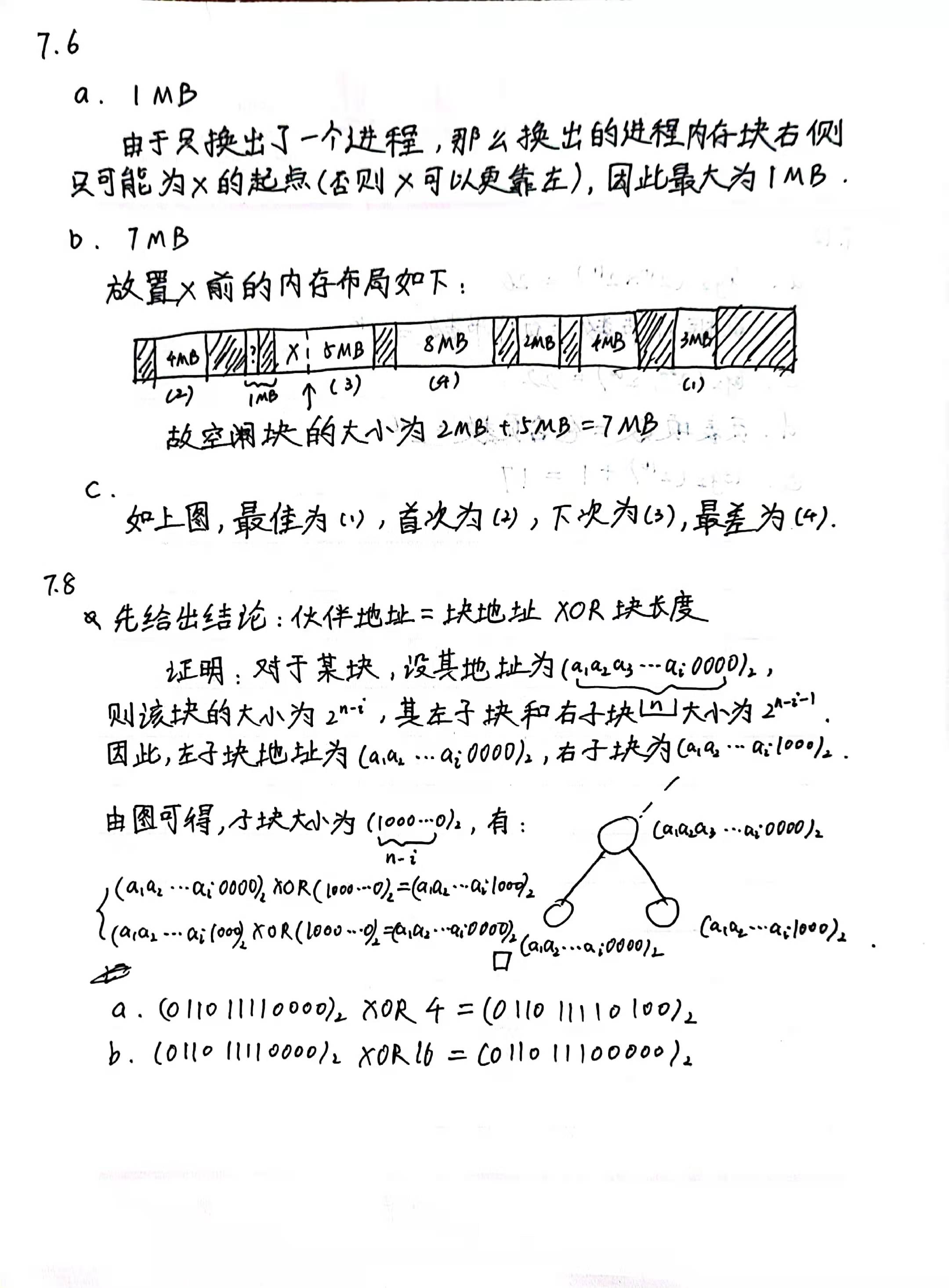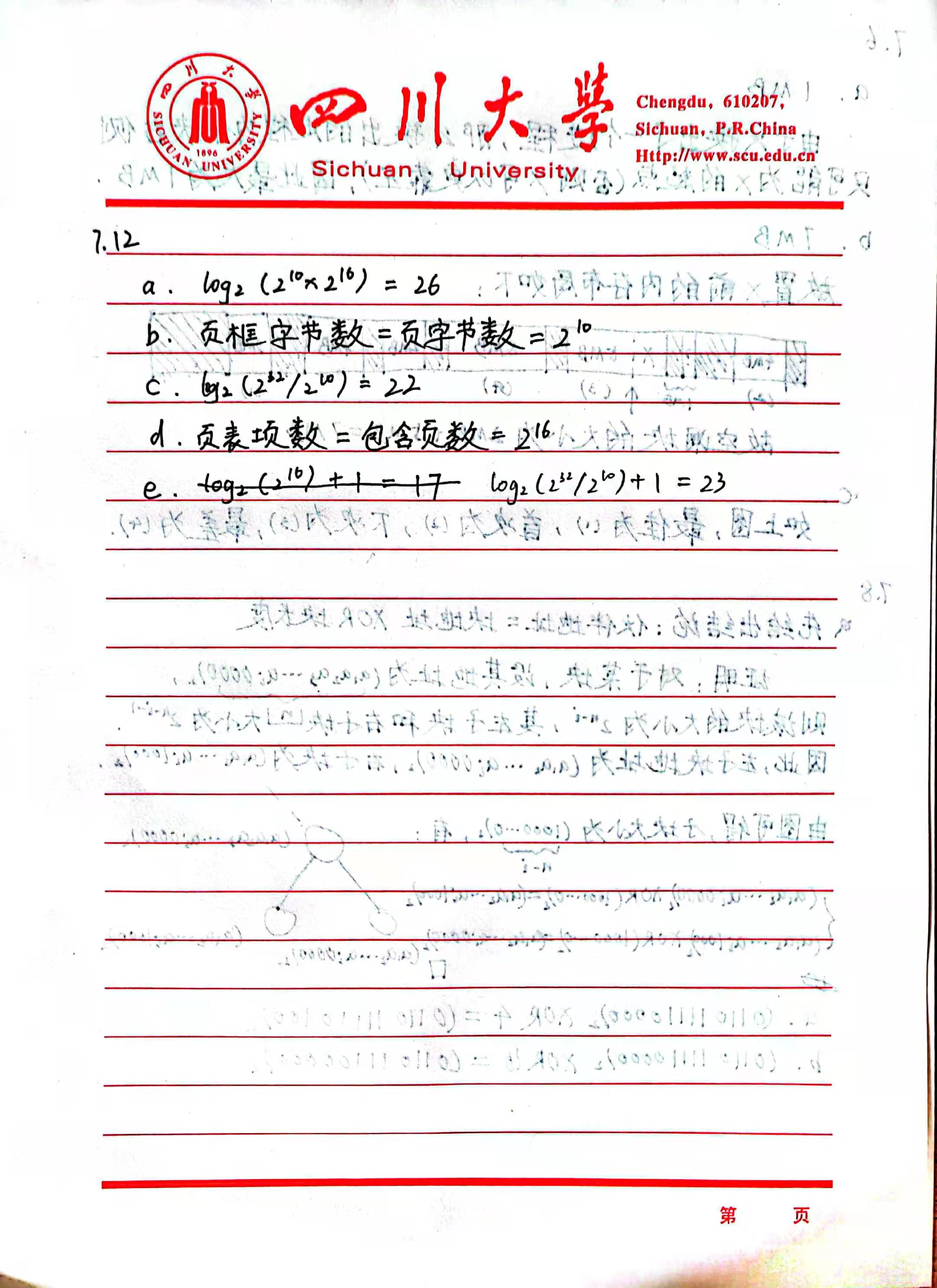(已完结)OS笔记
只提供理论部分,供期末复习用。
Computer System Overview
偏计组,考试不考。
- Fetch-Execute.
- Interruption: program flow chart, ISR (Interrupt Handler) level.
Operating System Overview
OS: a program that controls the execution of application programs, and acts as an interface between applications and the computer hardware.
Interrupts: Early computer models did not have this capability. This featuregives the OS more flexibility in relinquishing control to, and regaining control from, user programs.
Process Description and Control
process
交替执行(interleave)、策略(stategy)、死锁(deadlock).
definition:
- 一个正在执行(running, executing)的程序。
- 一个正在计算机上执行的程序实例
- 能分配给处理器并由处理器执行的实体
- 由一组执行的指令、一个当前状态和一组相关的系统资源表征的活动单元。
component:
- ID
- State
Threads
Thread: lightweighted process.
Linux has no kernel threads while Windows does, the advantanges of no threads are lightweighted and easy to manage.
Concurrency
terminology
- atomic operation
- critical section
- deadlock
- livelock
- mutual exclusion
- race condition
- starvation
单道程序的特点:
- 封闭性
- 连续性
- 可再现性
多道程序的特点:
- 失去封闭性
- 间断性
- 不可再现性
algorithm
dekker
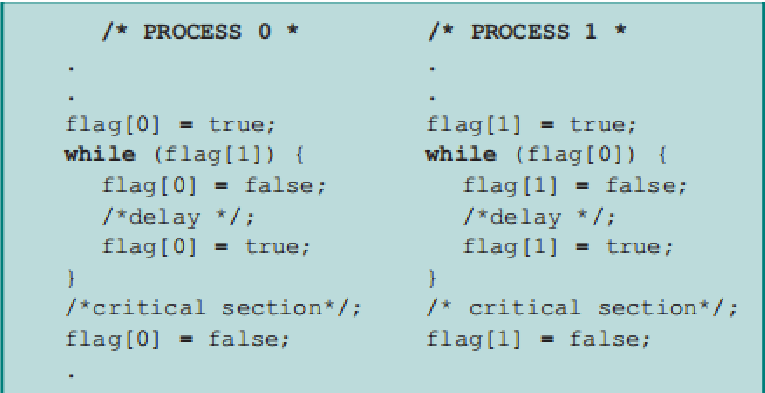
- 存在活锁。
- 规定了进程执行的顺序,不灵活。
- 程序实现复杂,难以验证。
peterson
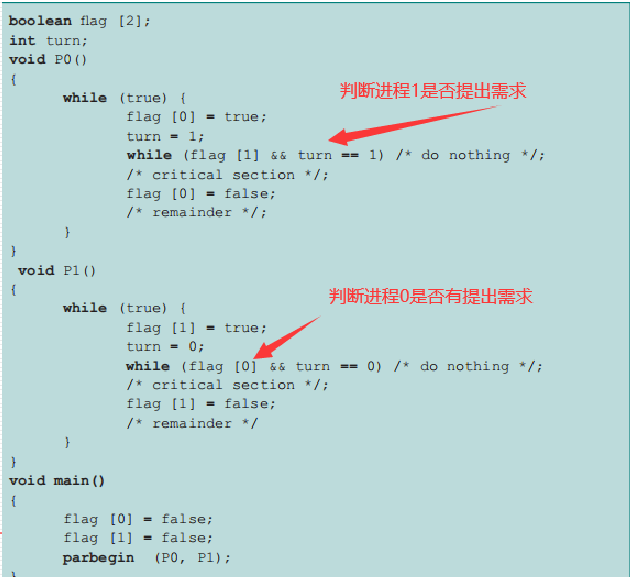
hardware disabling
disadvantage:
- Processor is limited in its ability to interleave programs.
- disabling interrupts on one processor will not guarantee mutual exclusion in multi-processors environment。
special instruction
优点:进程数目不限、简单易证、支持多临界区。
缺点:忙时等待、饥饿、死锁。
Semaphores
terminology
- 二元信号量
- 计数信号量
- 互斥量
- 强信号量
- 弱信号量
operation
- semwait: 申请一个资源/等待一个条件
- semsignal: 释放一个资源/产生一个条件
- 如果前两者在一个进程出现,称为互斥;如果不在一个进程出现,称为同步
- 对于semwait,先处理同步,再处理互斥
step
- determine the number of processes
- analysis of the nature of the problem
- define the semaphore and initialize the value of the semaphore
- calling semwait and semsignal in the process
1 | Semaphore(a,b,c) |
problems
生产者消费者问题:
1 | void producer() { |
读者写者问题:
rw,ww之间互斥
rr之间互斥(条件竞争)
读者优先:
1 | Semphore mutex = 1; //文件互斥量 |
读写平等:
1 | Semphore mutex = 1; //文件互斥量 |
Monitors
composition
- local data
- cond variables
- waiting area (queue)
cwait(cond)csignal(cond) - procedures
- init code
天生互斥。(同一时间最多只有一个活跃的procedure)
message passing
send(dest, msg)
receive(src, msg)
天生具有同步关系
同步阻塞:你饿了,叫你妈妈做饭,然后你一直等。
同步非阻塞:你饿了,叫你妈妈做饭,你去打游戏,时不时问妈妈饭做好没。
异步阻塞:你饿了,叫你妈妈做饭,你去打游戏,妈妈说饭做好了,你去吃饭。
异步非阻塞:你饿了,叫你妈妈做饭,你去打游戏,妈妈说饭做好了,把饭端给你。
优势:跨主机,可在网络编程使用。
Deadlock & starvation
没有通用有效解决方案。
why deadlock
- 资源有限
- 资源的请求和释放的顺序不恰当
recourses
- 可重用资源(CPU、内存、数据库、信号量等)
- 可消费资源(中断、信号等)
requirement
- 互斥
- 占有且等待
- 非抢占
- 循环等待(前三种是必要条件,加上这一种是充分条件)
resolve
allow deadlock
- 鸵鸟算法(无视)
- 死锁检测
死锁检测具体算法:
例:
- 在
Allocation中找零向量。- 设
w=v- 在
Request中找小于w的行向量,标识时清零A并更新w向量。- 重复第三步,直到不能再比较(死锁)或者消除完为止(无死锁)。
- 死锁消除(杀死CPU时间最少的、输出最少、等待时间最长或优先级最低的)
don't allow
- 死锁预防(静态)
- no mutual exclusion (成本问题)
- no hold and wait, requesting all resources at one (可行,但无法判断进程需要哪些资源)
- preemption (可行,需保证被抢占进程易保存恢复)
- define a linear ordering of circular wait (可行,没有考虑进程的实际需求)
- 死锁避免(动态)
- process initiation denial: for all j,
. - banker's algorithm(缺点:最大资源、孤立考虑、分配资源数目固定、子进程不能退出、时空复杂度高)
- process initiation denial: for all j,
banker's algorithm details:
例:
将ABCD都验证一遍就行。
- (安全检测算法)用
向量比较 的某一行,如果大于, ,直到不能再比较(不安全)或者消除完为止(安全)。
- (银行家算法)把新的请求加到
矩阵里(本题中加到 P5变成),然后 向量变成 ,再执行步骤c$
dining philosopher's problem
initial solution (incorrect)
problem: possible deadlock (all five philosophers take one fork)
1 | sem p[i] = 1 from 0 to 4 |
solution1:
1 | sem p[i] = 1 from 0 to 4; |
solution2:
1 | sem p[i] = 1 from 0 to 4; |
Q: What about 2 dynamic algorithms?
(TODO)
设共有
memory management
- 固定分区,动态分区:全部加载,不分区。
- 简单分页,简单分段:全部加载,分区。
- 虚存分页,虚存分段:部分加载,分区。
固定分区
- pros: 简单,很少的操作系统开销。
- cons: 限制了活动进程的数量,小作业不能有效利用分区空间(内部碎片)。
动态分区
- pros: 更充分利用内存,没有内部碎片
- cons: 需要压缩外部碎片,处理器利用率低
产生外部碎片(使用压缩算法解决)
放置算法(最佳适配、首次适配、下次适配)
一个进程在生命周期内占的内存位置可能不相同(压缩和交换技术)
伙伴系统
类似于二叉树
优于固定和动态分区,存在内部碎片
简单分页
def: 页框、页、段
每个进程都有一个页表,页表给出了该进程的每页(逻辑,page)所对应页框(物理,frame)的位置。
逻辑地址包括一个页号和该页中的偏移量。通过页表查询页号的页框号(前6位),与偏移相拼接(10位)得到物理地址。
存在少量内部碎片。
简单分段
与进程页表只维护页框号不同,进程段表维护了长度与基地址。
逻辑地址包括一个段号和偏移量。通过段表查询段号对应基地址(16位),将其与偏移相加(12位)得到物理地址。
存在外部碎片。
内存管理需求
- 重定位(物理地址、逻辑地址、相对地址、基址寄存器、界限寄存器)
- 保护(由硬件满足)
- 共享(允许多个进程访问内存的同一部分)
- 逻辑组织(程序使用模块编写的,模块可以单独编译,提供不同保护)
- 物理组织(程序员不知道客户的内存限制)
homework:
更正:由于存在一种机制叫重定位(如果 X 曾经就在原来那个位置,之后被 free 掉,之后重新 malloc 会仍然在该位置,而不会靠左),所以
7.6.a仍然是8MB,第二题则应更正为[3M, 8M].
Virtual Memory
- 固定分区,动态分区:全部加载,不分区。
- 简单分页,简单分段:全部加载,分区。
- 虚存分页,虚存分段:部分加载,分区。
虚存分页
简单来说就是把一部分内存放到硬盘里,等到需要的时候再加载到内存。
如果读取的页位于磁盘,则产生一个缺页中断阻塞进程,等从磁盘加载到内存后再产生一个中断恢复执行。(因此一次缺页会产生两次中断,如果中断时间大于执行指令的时间就会产生“抖动”)
对于32位4GB内存的分页,操作系统在内存保存一个4KB根页表(每项4字节,共有1024个页表项),该根页表中的每一项对应一个4KB的页表(每项4字节,共有1024个页表项,因此一共有1048576个页表项,共计4MB,可以保留在虚存),这4MB的虚存空间每一项对应一个长度12位的虚存(因此这1048576项就可以映射到4GB的虚存中)。
for pwners: 这就是为什么地址ASLR的后三位不变,ASLR只会按页随机,不会随机页内部的偏移。
将虚拟地址转化为物理地址的方法如下:首先用前10位作为根页表的偏移,查到对应的根页表项,接着判断该根页表项对应的用户页表(4MB那个)是否在内存。如果在,就用接下来10位查找对应的对应的用户页表项,并用该项的页框号和偏移得到物理地址;如果不在,就产生缺页中断。
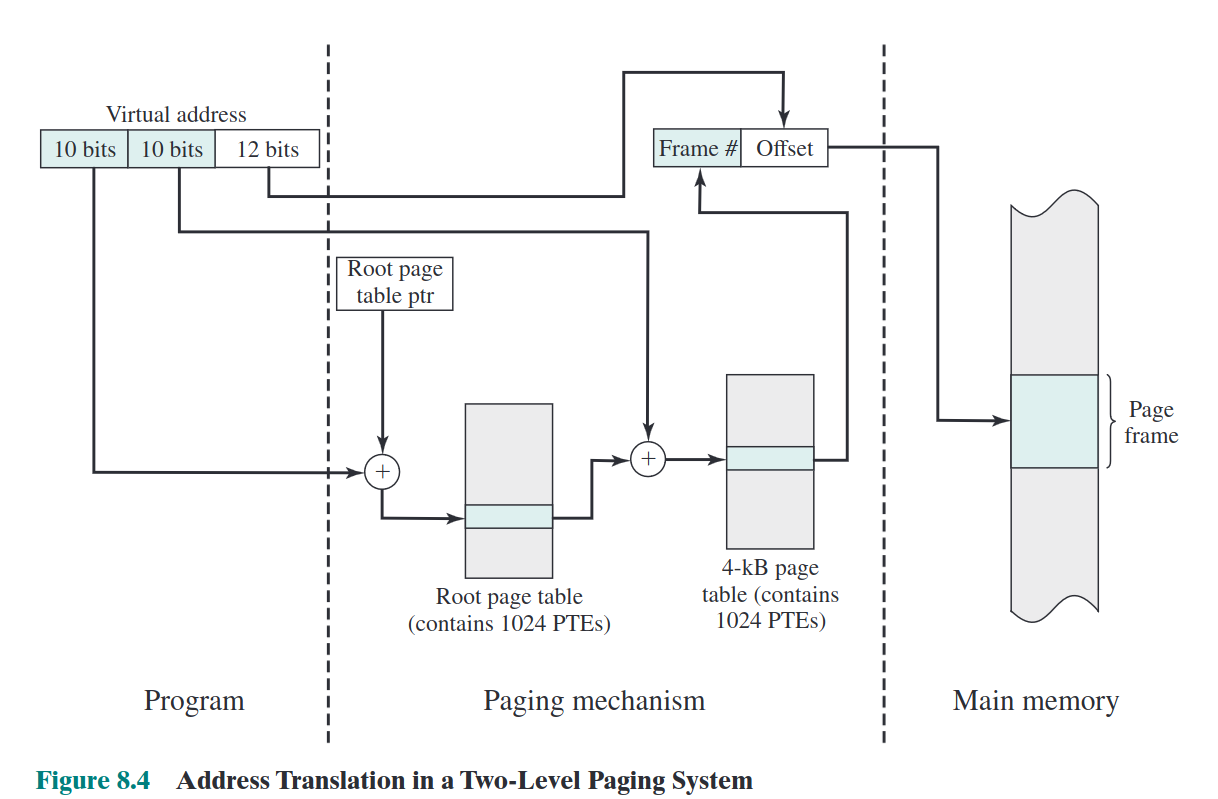
转换检测缓冲区可以可以缓存部分页号对应的页框号,从而减少中断,提高内存访问速度。
页尺寸与缺页率的关系是先增后减(局部性原理;整个进程都在页当中),页框数和缺页率的关系是单调递减(如果页和页框都一一对应就没有缺页了)
虚存分段
虚拟地址由页号和偏移量组成。转化为物理地址的方式是,页号作为偏移在段表内寻找对应的段号,将该段的基地址与虚拟地址的偏移相加得到物理地址。
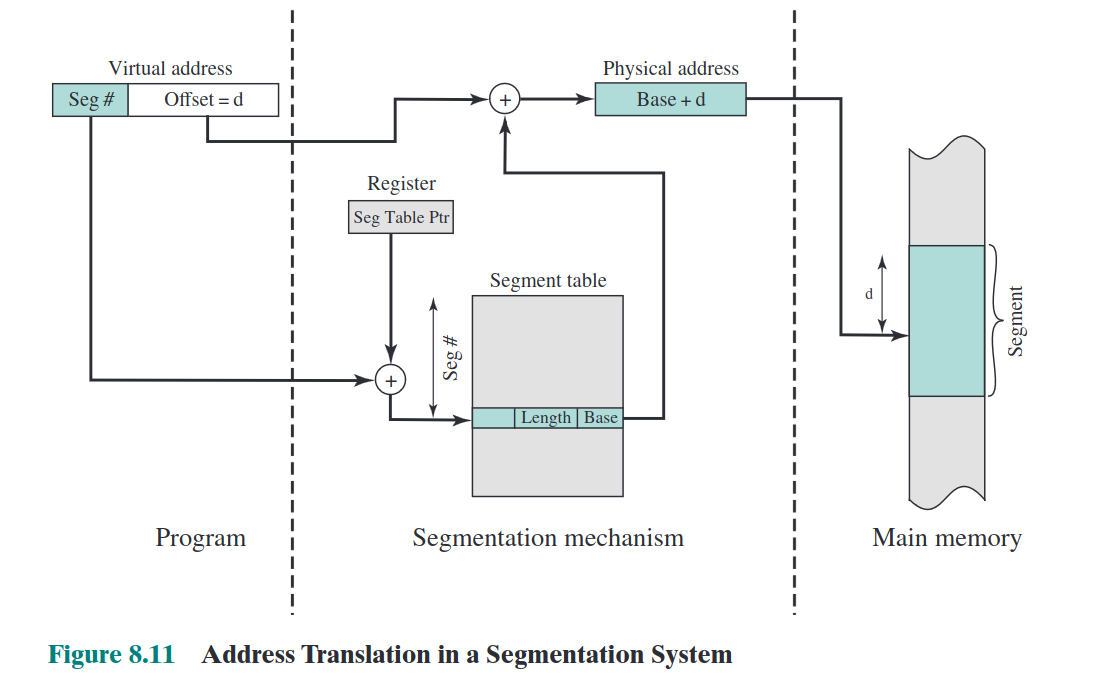
OS层面
读取策略
- 请求分页式:要才给。(启动时一堆缺页)
- 预约分页式:启动时就给一堆。(大部分要的可能不会访问)
放置策略(同前文放置算法)
决定一个进程块驻留的物理位置。
置换策略
页框锁定:不会被换出(如内核等)
- OPT:替换未来访问时间最远的那个页(理想方式,缺页中断最少,需预测未来访问)
- LRU:最近最少使用(开销大,每页都需要打时间戳)
- FIFO:停留时间最多的先出去(最简单)
- CLK:带
used标记的FIFO(折中与LRU与FIFO) - PB:减少I/O操作时间
CLK 实现代码:
1 | pageSize = 3 |
驻留集管理
- 固定分配:给进程的页框数固定。
- 可变分配:缺页率高多分配,缺页率低少分配。
- 局部置换:置换缺页进程的驻留页。
- 全局置换:置换整个内存中未锁定的页。
清除策略
- 请求式清除:被置换才放回辅存。
- 预约式清除:提前放回辅存。
加载控制
影响到驻留在内存中的进程数量(系统并发度)与处理器利用率。
随着并发数量的增加,处理器利用率增加。达到一定程度后,平均驻留集大小不够,中断增加,处理器利用率降低。
processor scheduling
types
- Longterm scheduling (job scheduling,长程调度)
- Medium-term scheduling (swaping out processes,中程调度)
- Short-term scheduling (syscall, I/O,短程调度)
- I/O scheduling: deciding which process can use an available I/O device.
algo design
requirements
(non)preemptive: a process can be dispatched when the executing process is not finished.
performance: - turnaround time & response time - throughput & deadline - utilization
fairness & starvation
algos
- non-preemptive
- FCFS: first come first serve
- not average turnaround time, throughput
- no starvation but biased toward long processes
- SPN: shortest process next
- scheduling repetitive tasks (OS don't know how long a process will execute)
- optimized turnaround time, throughput
- long process may starve, biased toward short processes
- HRRN: highest response ratio next
- equally treat performance and fairness
- avoid starvation of long processes at some extent
- FCFS: first come first serve
- preemptive
- RR: round robin
- depended on slice thinkness
- short means quick response but long turnaround, vise versa.
- SRT: shortest remaining time
- scheduling repetitive tasks (OS don't know how long a process will execute)
- more optimized turnaround time, throughput
- long process may starve, biased toward short processes
- MLFQ: multi-level feedback queue
- one queue for each priority level, new process priority is 0 (maximum)
- if release before inturrupted, stay same priority
- if preempted/interrupted, move to the next priority
- RR: round robin
Real-time scheduling
EDF
earlist deadline first
for non-scheduled
RM
rate monotonic (higher rate/frequency first)
for scheduled
I/O
ALL OPERATIONS ARE NON-PREEMPTIVE!!
buffering
aim: reduce process stuck time to improve efficiency
type
- single buffer: suitable sequential data access, concurrent read/write not allowed.
- double buffer: enables concurrect read/write, still stuck if
& a new I/O requrest happened. - circular buffer: circular queue (
).
disk scheduling
transfer (fixed)
rotation (fixed)
seek
policies:
- priority (starvation for low-priority processes)
- FIFO (not optimized performance)
- LIFO (not optimized, but good for transaction processing)
- SSTF (shortest service time first, faster than FIFO)
- Scan (move the arm in one direction, choose the closest request in the same direction, reverse the direction until it reaches the end)
file
what
abstration to manage and access data.
components
field:
- basic data element
- contains a single value
- of fixed or variable length
record:
- collection of related fields
- basic unit of application data
- of fixed or variable length
file:
- collection of related records
- managed as a single entity
- identified and refereced by a name
block:
- a continuous collection of data
- contains part of a file
- of fixed or variable length
- basic unit of file storage allocation
- basic unit of I/O buffering
requirements
- persistent
- shareable
- structure
file operation
basic: create, delete, open, close, read, write
directory
abstraction to organize files
single level
- file of all users placed under a single root directory
- users must handle name conflicts (a malicious user deliberate overwrite etc.)
two-level
- first layer is users' folders, second layer users' files under their folders
- users must handle their own name conflicts
hierachical
- used till now
access control
typical levels: - none - knowledge - execution - reading - appending - updating - changing protection - deletion
access rights:
- owner or previleged user (root): full rights, grant rights to others
- specific user: individual user (associated with user ID)
- user group: set of users
- public
in *nix system
- access modes: Read Write eXecute (RWX)
- access rights: ower, group, public
- access control grant:
rwxrwxrwx
file organization
criteria:
- short access time
- ease of update
- economy of storage
- simple maintenance
- reliability (x)
pile file
- files are organized as not-fixed records
easy to insert, difficult to search
sequential file
- files are organized as fixed, ordered records
- has a key field
- new records are placed in a log file
performance is still low
index sequential
- add indexes to entries in a sequential file to search quickly
- two step search: index & record
- overflow file
indexed
- sequential file builds indexes for one key field
- index file build indexes for multiple key field
- no contraints of records position, no overflow file
after an operation, all records need modification
direct file or hashed file
- indexed by a hash table, NOT sorted
- update and search a single record is easy
storage management
goal: manage the disk space to support a stream of file operations
two basic tasks:
file allocation
FAT: file allocation table
- contiguous
- good locality
- external fragmentation (improve by compression)
- chained
- each block has the pointer to the next block
- poor locality (improve by consolidation)
- high utilization and flexibility
- indexed (varible/block)
- FAT has a separate one-level index for each file
- the index contains an entry for each variable portion/block allocated to the file
- FAT contains block number for index block

free space management
- DAT: disk allocation table
- bit table size (S), number of blocks (N), diskcapacity (C), block size (s):
- chained:
- no DAT needed
- fragmentation
- long allocation/recycle time
- indexed
- free block list
- store the list of available blocks in the disk
- consume small portion of disk space
- some part can be in memory to speed up
复习提纲
2
操作系统的概念,与应用程序的区别 操作系统的功能、目标 操作系统的构成模块,简述功能 操作系统的发展(批处理、分时、实时) 分时系统和批处理系统的概念,差异 中断和异常在分时系统和批处理系统的作用 如何理解操作系统是一个虚拟机
3
为了实现进程,CPU需要提供哪些硬件支持(中断和异常)
什么叫进程,和程序的关系和区别 PCB的概念及功能,描述其构成
从程序生命周期的角度描述程序怎么变成进程 跟进程控制相关的原语有哪些
进程的五状态图(图相关) 从三个角度回答进程的运行(研讨题)
进程的创建流程,并结合Linux的fork(一次调用两次返回)
进程切换的流程和时机(wait)
4
线程的概念,进程和线程的区别 线程的三种实现方法 ULT和KLT的优缺点
5
并发需要解决的四个问题(同步、互斥、饥饿、死锁) 为什么引入同步互斥机制(race condition) 有哪些解决方案(软件类、硬件类、系统类(管程和信号量)) 硬件解决的缺点 信号量的概念、本质和实现 管程是什么,引入的原因是什么
6
死锁的概念和产生背景 死锁的条件(三个充分,四个充要) 死锁的解决方法(预防、避免、检测、不解决) 死锁和饥饿的关系
7
存储管理的7个方法 固定分区分页、动态分区分段的异同 段表和页表的构造和使用
8
实现虚拟存储要考虑的三个问题 实现虚拟存储的三个方法(虚拟分段,虚拟分页,段页式) 虚拟存储器 Page Fault 的处理流程 地址转化的计算 请简述缺页率和页尺寸和页框数的关系
9
长中短三个调度的描述(图相关)
10
IObuffer的产生背景和IObuffer的运行方式
12
文件系统的实现方式 逻辑层上有五种实现方式 物理层有三种实现方式
DIY笔记(第9章)
DIY教材:Operating Systems: Three Easy Pieces 的链接:https://pages.cs.wisc.edu/~remzi/OSTEP/
chapter 7: introduction
反应时间——一种新的度量方式
STCF算法主要从周转时间(turnaround time)方面进行优化,这种方法主要针对于早期批处理系统。但对于当今的分时系统(time-shared)来说,响应时间(response time)才是决定即时性能的重要因素。
响应时间的计算公式如下:
假设有三个进程
A,B,C同时在时刻进入队列,且每个进程的执行时间均为 5,则使用 STCF/SJF的调度情况如下图:
故平均响应时间为:
Round Robin
Round-Robin
算法是抢占式(preemptive)算法,可以显著提高各个进程的响应时间。RR不是运行作业完成,而是运行时间片(有时称为调度量子)。值得注意的是,时间片的长度必须是计时器中断周期的倍数,因此,如果计时器每10毫秒中断一次,则时间片可以是10、20或任何其他10ms的倍数。
还是以上一个为例,使用
Round-Robin调度的情况如下(单位时间片为1):
故平均响应时间为:
效果显著。
优点: - 显著减少响应时间 - 对进程公平
缺点: - 周转时间太慢
考虑 I/O 的情况
结论:如果使用非抢占的调度算法(如STCF),应当将频繁使用I/O的进程的时间块分割开来,以提高资源利用率。
例,
A和B都是需要 50ms 的进程,但A每 10ms 就要调用一次 I/O,花费 10ms 的时间。不分割时间块的情况,总用时 140ms:
分割时间块的情况,总用时 100ms:
通过将每个CPU突发作为一个作业来处理,调度程序可以确保“交互式”的进程频繁运行。当这些交互式作业执行I/O时,其他cpu密集型作业会运行,从而更好地利用处理器。
如果不能预知未来又该怎么办
STCF/SJF 算法在真实的操作系统作用有限,因为 OS
对每个进程的先验知识很少,改进方法可能有:
- 尝试从无需先验知识的
Round-Robin算法中改进,比如尝试改变时间片的长度以平衡反应时间与周转时间。 - 尝试对预测进程耗费的时间。
总结
本章我们学习了:
- 对反应时间的优化:
Round-Robin - 如何应对调度中的 I/O 行为
chapter 8:Multi-Level Feedback Queue
MLFQ试图优化的问题
在不知道一个作业需要运行多久的前提下优化周转时间
在优化周转时间的前提下减少交互式用户的响应时间
MLFQ的基本概念
MLFQ有许多不同的队列,每个队列分配了不同的优先级。在任何给定的时间,一个准备好的工作运行的作业都在一个队列中,MLFQ使用优先级来决定哪个工作 。
MLFQ的基本规则
- 规则一:如果A作业的优先级高于B作业的优先级,则运行A作业
- 规则二:如果A作业的优先级与B作业的优先级相等,则A作业与B作业交替运行
- 规则三:当一项作业进入系统时,该作业将会被置于最高的优先级(最上面的队列)
- 规则四:一旦某项工作耗完了当前优先级的时间片,则它的优先级将会被下降
- 规则五:经过特定长时间S后,所有的任务都将会被移到最高优先级的队列
MLFQ的具体实现
第一步
作业一进来,会被放置在最高优先级的队列进行运行
第二步
每个队列都设置了一个特定长度的时间片,当该作业耗尽该时间片时,该作业将会被置于下一级队列中
- 时间片的长度从最高优先级队列到最低优先级队列逐渐变长
- 作业主动中断CPU处理后,再次连接仍然位于之前的优先级,并使用未用完的时间片
第三步
经过特定的时间后,所有作业都将会被重新放置到最高优先级的队列之中
MLFQ存在问题
存在饥饿的问题:如果系统中有“太多”的交互式作业,它们将结合起来消耗所有的CPU时间。
通过游戏调度程序来骗取更多的资源
程序可能会随着时间的推移改变其行为 ### MLFQ的总结
MLFQ不需要先验知识,它通过观察执行情况来确定优先级
在整体性能上接近于SJF/STCF
对与短时运作的交互式作业有着很好的优化
对长时运作的作业也是公平的
chapter 9: proportional share
目的: 保证每个进程能获得一定的百分比的 CPU 时间。
彩票调度
每个进程拥有一些票据(ticket),系统随机选择所有票据中的一个,拥有该票据的进程执行命令。
根据大数定律,随着执行时间的增长,每个进程执行时间的百分比,最终会收敛于拥有票据占总票据的百分比。
基本概念
- 汇率(currency):每个用户可以设定自己的票据单位,并按照汇率分配给各个子进程。
- 转让(transfer):进程可以将汇率交给其它进程来暂时放弃它的执行权。
- 通货膨胀(inflation):对于一个进程间互相信任的环境,一个进程可以提高票据价格来获得更多 CPU 时间,而不需告知其它进程。
实现
利用随机数生成器来选择中奖彩票、记录系统中所有进程的数据结构(一个列表)、所有彩票的总数
假定我们用列表记录进程。有 A、B、C 这 3 个进程,在做出调度决策之前,首先要从彩票总数400中选择一个随机数(中奖号码)。假设选择了300。然后遍历链表,用一个简单的计数器帮助我们找到中奖者。
从前向后遍历进程列表,将每张票的值加到 counter 上,直到值超过 winner。 这时,当前的列表元素所对应的进程就是中奖者。例如,中奖彩票是300。首先,计A的票后,counter 增加到 100。因为100小于300,继续遍历。然后 counter 会增加到150(B的彩票),仍然小于300,继续遍历。最后,当counter增加到400(大于300)时,退出遍历,当前指针指向C就是中奖者。

- 优点:轻量化,几乎不需要记录任何状态;速度快
- 缺点:在工作运行时间很短的情况下,无法保证产生正确的比例
步长调度
取消了随机性,以固定步长代替,是一个确定性的公平分配算法。
步骤
- 例如
A,B,C的票据分别为100,50,250,这里设其步长为票据的反比(简单的做法是用一个大数分别除以它们),如果这个大数是10000,那么最后A,B,C的步长分别为100,200,40. - 设
A,B,C的总步数均为0. - 选取这三者中最小的,并加上它的步长。
- 重复步骤3.
最后的调度结果如下图:

- 优点:进程执行时间的百分比恰好就是票据的占比(而不是慢慢收敛到这个值)
- 缺点:不便于新进程的加入。
Linux CFS (选讲)
- 对于每个进程,通过调整
sched_latency和min_granularity和来兼顾效率与公平性(联想一下Round-Robin时间片太小和太大的危害) - 通过
nice这个 shell 命令调整进程的权重,具体而言,可以通过以下公式来求得每个进程的时间片大小:
具体的权重常数参见以下定义:
1 | // the map between nice param to weight |
- 通过
vruntime记录程序当前运行时间(不一定是真实的时间,可以理解为上文的步长),选择值最小进程的进行下一次运行。具体每运行runtime这么多时间,vruntime的更新公式如下:
其中
- 使用红黑树进行进程的管理。具体而言,使用红黑树这个数据结构可以使进程的插入、查询(找
vruntime最小的那个)、修改和删除的时间复杂度统一为 - 对于进行 I/O
操作或者睡眠进程的处理,系统将该进程的
vruntime设定为其余vruntime的最小值。
总结
本章我们学习了:
- 比例调度的两种方式: 彩票调度和步长调度。
- Linux CFS: 动态时间片、权重、红黑树与 I/O 处理。


